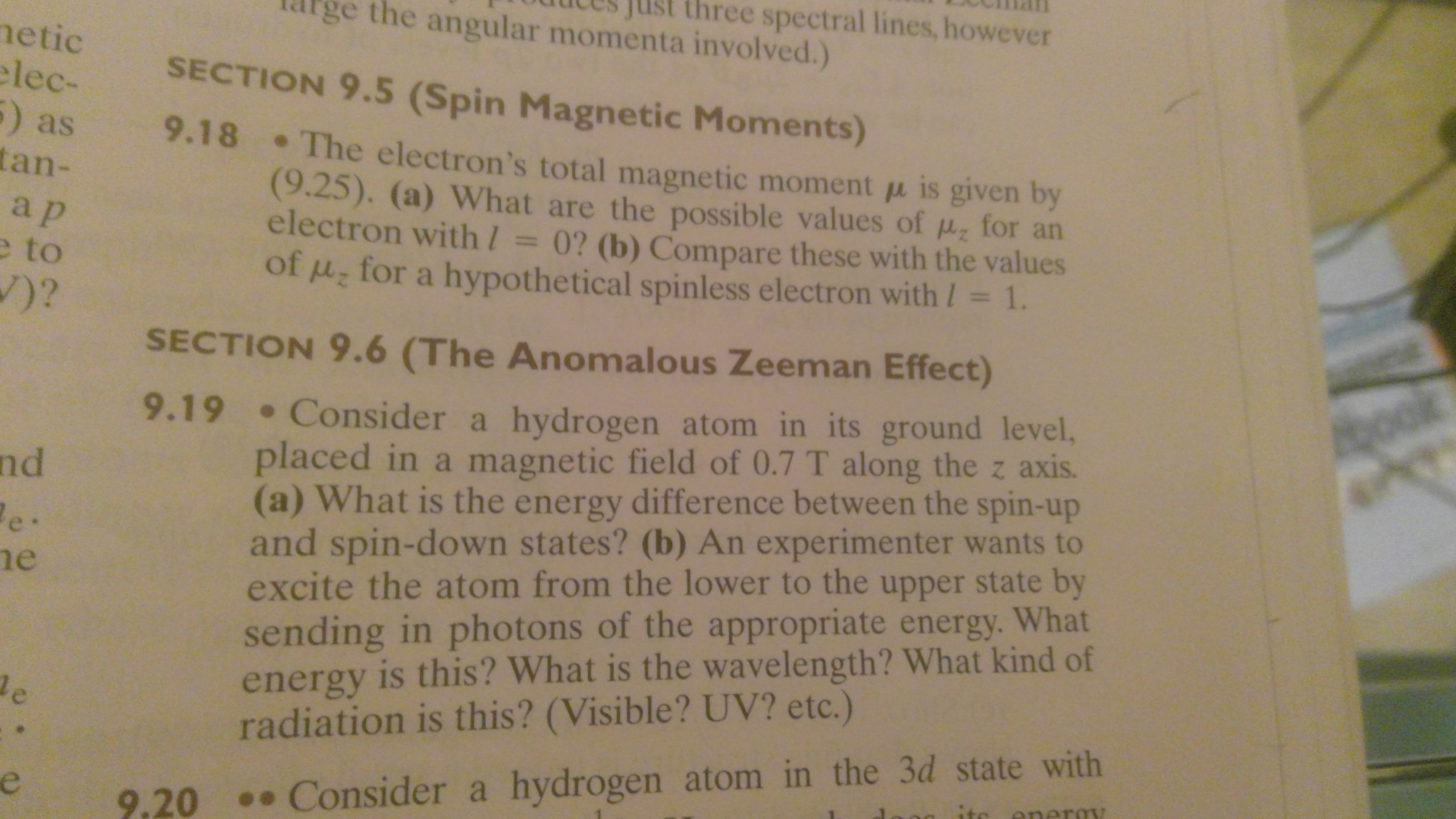Question
For Problem 9.18, how do I determine part A & B? This is from a chapter titled, "Electron Spin." This chapter is part of

Transcribed Image Text:hree spectral lines, however
the angular momenta involved.)
netic
lec-
) as
tan-
SECTION 9.5 (Spin Magnetic Moments)
9.18 The electron's total magnetic moment is given by
(9.25). (a) What are the possible values of for an
electron with/ = 0? (b) Compare these with the values
of u for a hypothe tical spinless electron with / 1.
a p
e to
)?
SECTION 9.6 (The Anomalous Zeeman Effect)
9.19 Consider a hydrogen atom in its ground level,
placed in a magnetic field of 0.7 T along the z axis.
(a) What is the energy difference between the spin-up
and spin-down states? (b) An experimenter wants to
excite the atom from the lower to the upper state by
sending in photons of the appropriate energy. What
energy is this? What is the wavelength? What kind of
radiation is this? (Visible? UV? etc.)
nd
e.
e
e
Consider a hydrogen atom in the 3d state with
itc eneroy
9.20
![should be a magnetic moment with the general form (9.23) and that the spin
gyromagnetic ratio does not necessarily have the same value as the orbital
ratio e/2me are both correct. Experiment shows that there is a magnetic mo-
ment with the form (9.23) and that the spin gyromagnetic ratio y is e me, just
wice the value of the orbital ratio, e/2me; that is,
Section 9.6 The Anomalous Zeeman Effect 297
George Uhlenbeck
and Samuel
Goudsmit
(1900-1988, Dutch, American)
(1902-1978, Dutch, American)
e s
Pl spin
(9.24)
me
The total magnetic moment of any electron is just the sum of its orbital
and spin moments
e
(L+ 2S)
2me
porb+ spin
(9.25)
ltot
As we describe in the next two sections, much of the evidence for the elec-
tron's spin comes from the repeated success of the formula (9.25) in explaining
a wide variety of experimental results.
The suggestion that the electron has a spin angular momentum and a
Uhlenbeck (center) and Goudsmit
(right) are shown here with col-
league Oskar Klein (left). In 1925
Goudsmit and Uhlenbeck, while
both graduate students at Leiden,
showed that several puzzles in
inined
nding magnetic moment given, as we now know, by (9.24)] is gener-
el Goudsmit and George Uhlenbeck
corre](https://content.bartleby.com/qna-images/question/81ed2a7d-ef58-4ac0-a29f-af1e2992bb8e/24878dba-06d5-407b-a02a-5479a1ace934/q6synw7.jpeg)
Transcribed Image Text:should be a magnetic moment with the general form (9.23) and that the spin
gyromagnetic ratio does not necessarily have the same value as the orbital
ratio e/2me are both correct. Experiment shows that there is a magnetic mo-
ment with the form (9.23) and that the spin gyromagnetic ratio y is e me, just
wice the value of the orbital ratio, e/2me; that is,
Section 9.6 The Anomalous Zeeman Effect 297
George Uhlenbeck
and Samuel
Goudsmit
(1900-1988, Dutch, American)
(1902-1978, Dutch, American)
e s
Pl spin
(9.24)
me
The total magnetic moment of any electron is just the sum of its orbital
and spin moments
e
(L+ 2S)
2me
porb+ spin
(9.25)
ltot
As we describe in the next two sections, much of the evidence for the elec-
tron's spin comes from the repeated success of the formula (9.25) in explaining
a wide variety of experimental results.
The suggestion that the electron has a spin angular momentum and a
Uhlenbeck (center) and Goudsmit
(right) are shown here with col-
league Oskar Klein (left). In 1925
Goudsmit and Uhlenbeck, while
both graduate students at Leiden,
showed that several puzzles in
inined
nding magnetic moment given, as we now know, by (9.24)] is gener-
el Goudsmit and George Uhlenbeck
corre
Expert Solution
This question has been solved!
Explore an expertly crafted, step-by-step solution for a thorough understanding of key concepts.
This is a popular solution
Trending nowThis is a popular solution!
Step by stepSolved in 5 steps with 4 images

Knowledge Booster
Similar questions
- Please solve all the questions in the photo.arrow_forwardProblem : Given the transfer function of a linear lung mechanics model S G(s) s3 + 3s2 + 2s a. Find the full-dimensional (3-D) controllable realization. b. Find a minimal realization. c. Verify the minimal realization is both controllable and observable.arrow_forwardPls answer thank youarrow_forward
- Consider the following wave function. TT X a = B sin(- (x) = E 2 π.χ. a −) + C · sin(² a. Does this function describes a particle-in-a-box acceptable wave function? Name the conditions to be fulfilled. b. Is this function an eigenfunction of the total energy operator H when H is the Hamilton operator.arrow_forwardinstead of V. 7) 16.2. Why might you expect the canonical partition function to scale exponentially with the system size, thus always ensuring that the Helmholtz free energy is extensive? 16.3. In a quantumarrow_forwardConsider the sheet formed by the intersection of the curves: x = 0, x = 4, y = 0, y = 3 [=] cm, with a variable density of mass per unit area ρ(x,y) = xy [=] g/cm2 . Write and evaluate multiple integrals to calculate the following: a. The area of the sheet [=] cm2 . b. The mass of the sheet [=] g. c. The shell moments about the x & y axes (Mx & My) [=] g∙cm. d. The position of the center of mass of the sheet ( , ) [=] cm.arrow_forward
arrow_back_ios
arrow_forward_ios